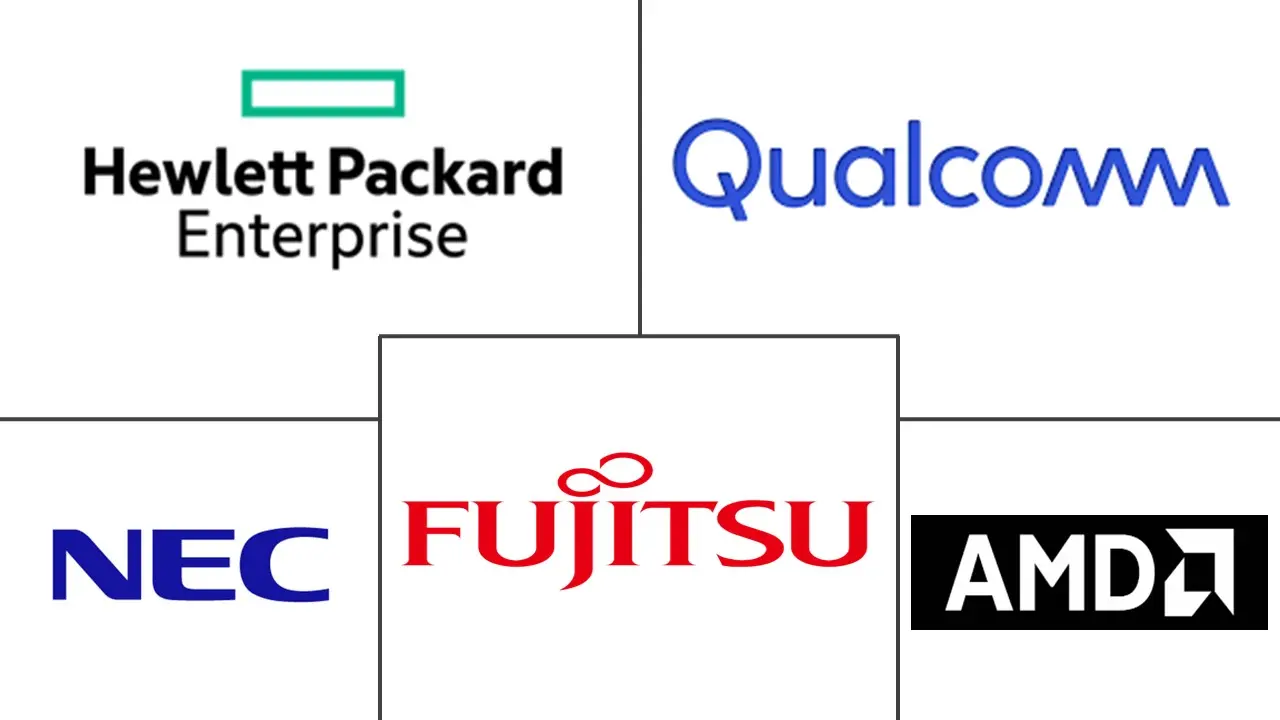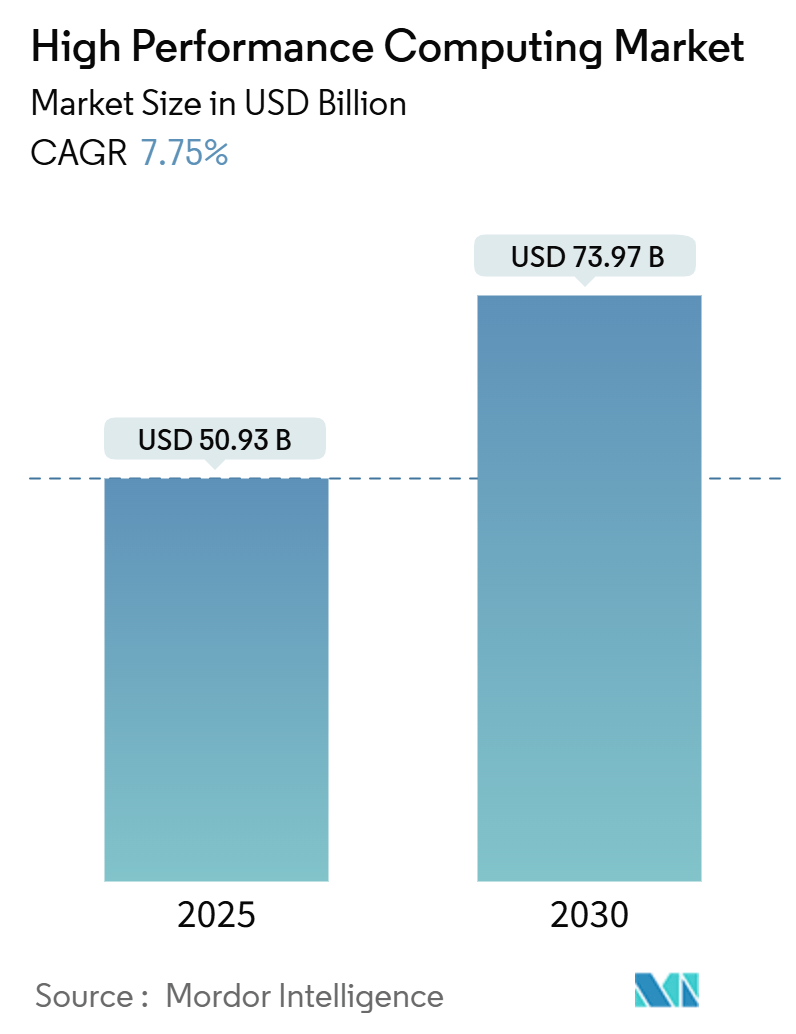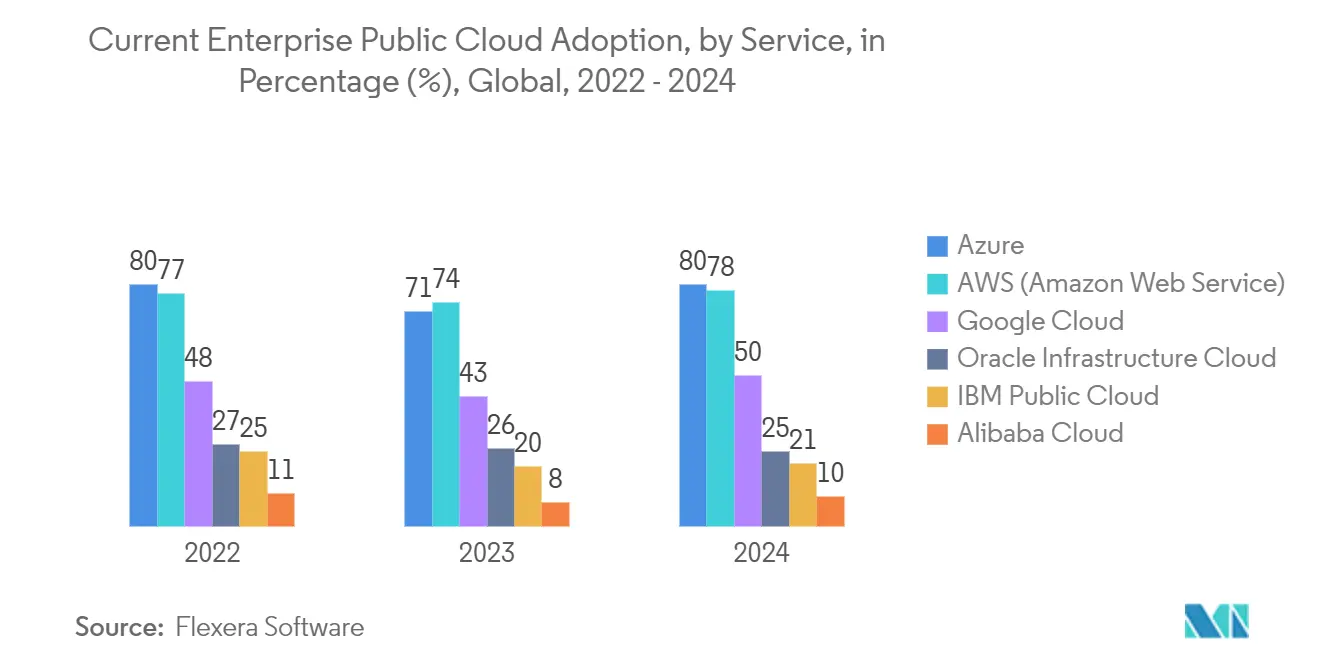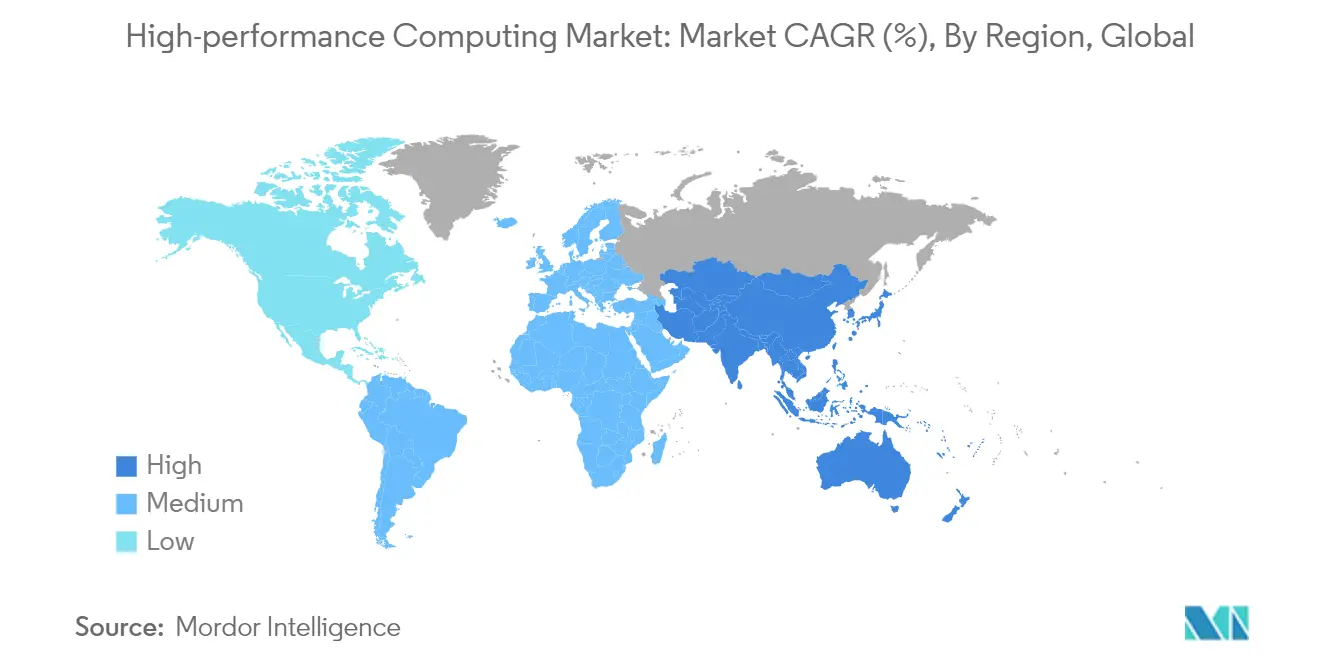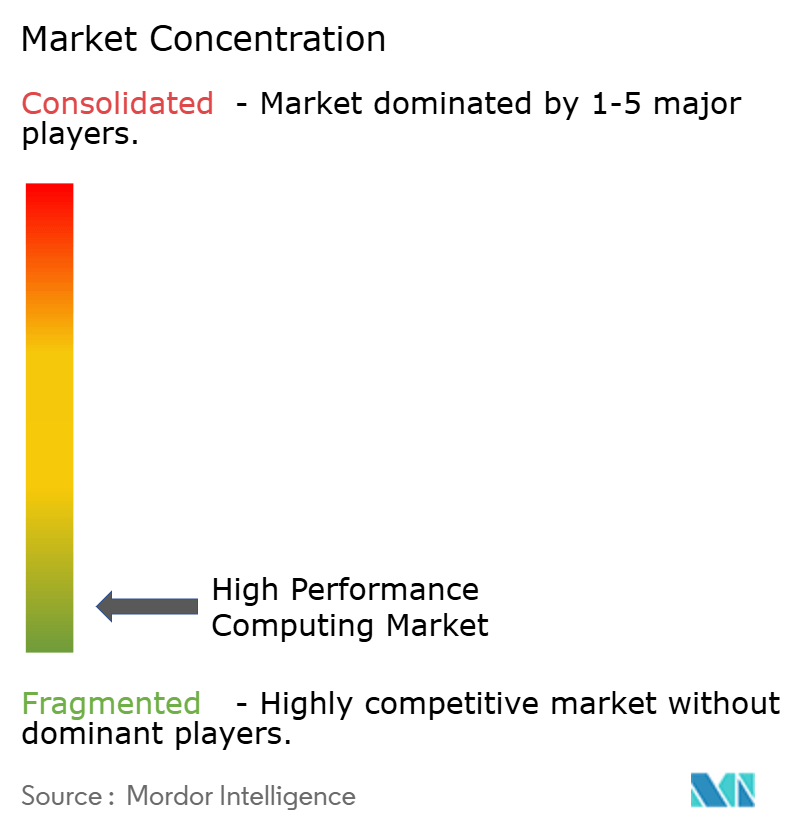High Performance Computing Market Analysis
The High Performance Computing Market size is estimated at USD 50.93 billion in 2025, and is expected to reach USD 73.97 billion by 2030, at a CAGR of 7.75% during the forecast period (2025-2030).
- High-Performance Computing (HPC) harnesses advanced computational techniques to address intricate problems demanding substantial processing power. By utilizing parallel processing architectures, high-speed interconnects, and specialized hardware like multi-core processors and Graphics Processing Units (GPUs), HPC systems excel in tasks ranging from large-scale simulations and scientific modeling to data analytics and Artificial Intelligence (AI).
- The market's expansion is driven by a surge in data centers and cloud services, aiming to simplify data complexities. Additionally, the growing embrace of quantum computing amplifies this trend. As more entities adopt cloud-based high-performance solutions for intricate application management, the market's potential continues to expand.
- Big data analytics is propelling the growth of high-performance computing (HPC), spurring demand for advanced computational systems, and driving innovations in HPC architectures and technologies. As big data analytics sifts through terabytes and petabytes of data, it necessitates robust computational resources, pushing the evolution of sophisticated HPC systems. Techniques such as machine learning and deep learning, integral to advanced analytics, demand high-performance processors, further cementing the reliance on HPC. The burgeoning needs of big data have birthed innovations, including GPU-accelerated HPC systems, high-bandwidth memory, and in-memory computing.
- On the contrary, despite advancements in HPC technology aimed at bolstering data security, concerns over cloud data security are dampening investments in the cloud. Businesses are wary of handling their sensitive data, especially with tightening public and governmental regulations. Such apprehensions could pose challenges to the global market for high-performance computing systems.
- Public skepticism towards cloud-based storage has intensified, fueled by a surge in hacking incidents and a general lack of awareness about security measures. While cloud storage boasts data safety through multiple copies stored in diverse geographical locations—sometimes even across countries—this very feature complicates private data accessibility, especially in the absence of clear international laws.
- Macroeconomic factors wield considerable influence over the high-performance computing (HPC) industry, shaping its demand, investment patterns, and innovative strides. When the economy thrives, sectors such as finance, healthcare, and manufacturing — all of which depend on data analytics, simulations, and modeling — ramp up their investments in HPC. Conversely, during economic slumps, companies often tighten their IT budgets, leading to postponed HPC upgrades or a hesitance in adoption.
High Performance Computing Market Trends
Cloud Deployment Model is Expected to Witness Significant Growth
- Cloud deployment in the high-performance computing market refers to the utilization of cloud-based infrastructure and services to execute complex computations and data-intensive tasks. This deployment model allows organizations to access scalable resources on-demand, including computing power, storage, and networking capabilities, without the need to invest in physical hardware. By leveraging the cloud, HPC users can run simulations, analyze big data, and conduct scientific research with improved flexibility and cost-efficiency.
- In October 2024, Citi and Google Cloud joined forces in a strategic, multi-year agreement to support Citi's digital strategy through cloud technology and artificial intelligence (AI). This collaboration focuses on modernizing Citi's technology infrastructure and enhancing employee and client experiences on cloud-based applications. By modernizing its technology infrastructure on Google Cloud, Citi will unlock the ability to offer improved digital products, streamline employee workflows, and run high-performance computing (HPC) and analytics platforms.
- In September 2024, AMD collaborated with the Vultr Cloud Alliance to integrate its advanced AMD Instinct MI300X GPU accelerators with Vultr's global cloud infrastructure. This collaboration combines AMD's top-tier computing power with Vultr's scalable cloud services, delivering high-performance AI and HPC solutions tailored for enterprises across industries. AMD, a leader in high-performance computing, delivers the AMD Instinct MI300X GPUs and the ROCm open software ecosystem. The AMD Instinct MI300X GPU excels with its high processing power and substantial memory capacity, ideal for handling complex AI models and HPC workloads. AMD ROCm software ecosystem enhances this with robust support for major AI frameworks such as PyTorch and TensorFlow, fostering flexibility and rapid development.
- In August 2024, the Telangana VFX, Animation, and Gaming Association (TVAGA) and Nebula Cloud, Asia's first fully managed High-Performance Computing (HPC) platform, signed a Memorandum of Understanding (MOU). This strategic partnership is set to transform the Animation, VFX, Comics, Gaming, and Immersive Media (AVCGI) industry by delivering advanced cloud technologies that enhance productivity, drive innovation, and accelerate digital transformation. TVAGA members will receive exclusive access to Nebula Cloud's HPC platform, designed to meet the demanding computational needs of the AVCGI industry.
- According to the latest report by Flexera, in 2024, 80% of enterprises reported adopting Microsoft Azure for their public cloud requirements. High-Performance Computing (HPC) clusters seamlessly unite to meet performance benchmarks. Designed to process vast data volumes, AI systems rely on optimized hardware capable of executing trillions of calculations per second. By synchronizing dense computer clusters, HPC powers the most advanced AI. This convergence of HPC and AI is being harnessed by enterprises across sectors, including finance and manufacturing.
- As the global cloud infrastructure expands, IT managers, HPC practitioners, and business leaders increasingly embrace HPC Cloud. This shift not only fosters collaboration and enhances reporting but also boosts user productivity, reduces operational risks, and accelerates time-to-market. Amid rising demand for AI/ML techniques, industries leverage cloud HPC's hardware, software, and services to navigate challenges and strengthen vital projects. This evolution highlights agility and flexibility as key competitive advantages, driving discoveries for businesses prioritizing a cloud-first HPC strategy.
North America is Expected to Hold Major Share
- As the cloud infrastructure in the region has scaled and advanced, practitioners of High-Performance Computing (HPC), IT managers, and business leaders have unearthed further advantages of HPC. The United States and Canada embrace cloud technologies and harness HPCs' capabilities across various sectors. Major players, including Google, Microsoft, IBM, and Amazon, are ramping up investments in the region's cloud infrastructure. Furthermore, heightened activities from vendors promoting the adoption of HPC are poised to propel the market's expansion.
- HPC is revolutionizing real-time data processing across aerospace, finance, healthcare, and manufacturing industries. For instance, the United States is at the forefront of adopting HPC technologies in the aerospace industry. HPC enhances the accuracy of aircraft performance simulations throughout the flight envelope and streamlines product design, hastening the time-to-market and cutting costs. Moreover, with broader access to HPC for digital simulations, the once-nascent realms of space travel commercialization and the space-based industry have witnessed unprecedented efficiency gains. Moreover, the defense industry in the country is significantly investing in adopting HPC technologies. For instance:
- In February 2024, U.S. Navy researchers will seek industry collaboration to enhance high-performance computing (HPC) and networking technologies. These technologies include Ethernet, SONET, Packet-over-SONET, Fibre Channel, and InfiniBand. The initiative will target several pivotal areas: bolstering HPC research, crafting next-gen network protocols, and creating hardware and software solutions, particularly in data storage. By addressing these areas, the initiative is expected to drive demand for HPC by enabling faster data processing, improving network efficiency, and supporting advanced computational tasks. Furthermore, the project will explore performance analysis, HPC applications, and quantum information science while also providing research management support.
- In November 2024, the U.S. Department of Energy (DOE) unveiled a USD 4 million federal investment, targeting 10 projects spread across eight states. This funding funneled through the DOE's High-Performance Computing for Energy Innovation (HPC4EI) initiative, zeroes in on harnessing supercomputing resources to address pivotal manufacturing challenges. The HPC4EI initiative also encompasses the High-Performance Computing for Manufacturing (HPC4Mfg) and High-Performance Computing for Materials (HPC4Mtls) programs, underscoring the DOE's dedication to industrial and materials innovation via HPC. Such initiatives are expected to drive demand in the high-performance computing market by fostering the adoption of HPC solutions across manufacturing sectors to achieve these objectives.
- As the demand for high-performance hybrid computing (HPC) solutions surges, the region's market is poised for significant expansion. This heightened demand for HPC resources propels innovation and hastens product development cycles. In response, numerous companies are actively channeling investments to spearhead innovations in HPC solutions.
High Performance Computing Industry Overview
The vendors in the High-Performance Computing market are semi-consolidated with an array of products and solutions. However, major vendors such as Advanced Micro Devices Inc., NEC Corporation, Hewlett Packard Enterprise, Qualcomm Incorporated, Fujitsu Ltd, Intel Corporation, and many more are highly preferred High-Performance Computing solution/product providers across various end users in different regions.
The major players in the market account for a significant market share and have considerable influence on the overall market. The major factor driving their production is their capability to achieve sustainable competitive advantage through innovation.
Innovation can give companies a sustainable competitive advantage. Market incumbents have been adopting powerful competitive strategies based on product differentiation and market expansion, among other activities.
The brand identity associated with the companies has a major influence on the market. Strong brands are synonymous with better solutions, so long-standing players are expected to have the upper hand.
The demand for the technology is expected to further experience high growth in the emerging regions, with companies aiming to attract these markets. Most of the factors mentioned above are in support of the industry. Thus, the overall intensity of competitive rivalry in the market is high.
High Performance Computing Market Leaders
-
Advanced Micro Devices, Inc.
-
NEC Corporation
-
Hewlett Packard Enterprise
-
Qualcomm Incorporated
-
Fujistu Limited
- *Disclaimer: Major Players sorted in no particular order
High Performance Computing Market News
- November 2024: IBM Corporation partnered with Advanced Micro Devices, Inc. (AMD) to roll out AMD's Instinct MI300X accelerators as a service on the IBM Cloud. Set to launch in the first half of 2025, this initiative seeks to boost performance and power efficiency for generative AI models and high-performance computing (HPC) tasks tailored for enterprise clients. Furthermore, this partnership will integrate support for AMD's MI300X accelerators into IBM's watsonx AI and data platform, alongside AI inferencing capabilities in Red Hat Enterprise Linux.
- November 2024: Hewlett Packard Enterprise announced its latest high-performance computing (HPC) and artificial intelligence (AI) infrastructure portfolio, which includes leadership-class HPE Cray Supercomputing EX solutions, and two systems optimized for large language model (LLM) training, natural language processing (NLP), and multi-modal model training. These advanced supercomputing solutions aim to accelerate scientific research and innovation for a global clientele.
High Performance Computing Industry Segmentation
The high-performance computing (HPC) market is defined based on the revenues generated from the sale of hardware, software, and services used in various industrial applications such as aerospace and defense, energy and utilities, BFSI, media and entertainment, manufacturing, life science and healthcare, and other industrial applications, across the regions such as North America, Europe, Asia Pacific, Latin America, and Middle East & Africa. The analysis is based on the market insights captured through secondary research and the primaries. The report also covers the major factors impacting the growth of the market in terms of drivers and restraints.
The high-performance computing (HPC) market is segmented by component (hardware [servers, storage devices, systems, networking devices], software and services), deployment type (on-premise and cloud), industrial application (aerospace and defense, energy and utilities, BFSI, media and entertainment, manufacturing, life science and healthcare, and other industrial applications), and Geography (North America, Europe, Asia Pacific, Latin America, and Middle East and Africa). The market sizes and forecasts are provided in terms of value in USD for all the above segments.
| By Component | Hardware | Servers |
| Storage Devices | ||
| Systems | ||
| Networking Devices | ||
| Software and Services | ||
| By Deployment Type | On-premise | |
| Cloud | ||
| By Industrial Application | Aerospace and Defense | |
| Energy and Utilities | ||
| BFSI | ||
| Media and Entertainment | ||
| Manufacturing | ||
| Life Science and Healthcare | ||
| Other Industrial Applications | ||
| By Geography*** | North America | |
| Europe | ||
| Asia | ||
| Australia and New Zealand | ||
| Latin America | ||
| Middle East and Africa |
High Performance Computing Market Research FAQs
How big is the High Performance Computing Market?
The High Performance Computing Market size is expected to reach USD 50.93 billion in 2025 and grow at a CAGR of 7.75% to reach USD 73.97 billion by 2030.
What is the current High Performance Computing Market size?
In 2025, the High Performance Computing Market size is expected to reach USD 50.93 billion.
Who are the key players in High Performance Computing Market?
Advanced Micro Devices, Inc., NEC Corporation, Hewlett Packard Enterprise, Qualcomm Incorporated and Fujistu Limited are the major companies operating in the High Performance Computing Market.
Which is the fastest growing region in High Performance Computing Market?
Asia Pacific is estimated to grow at the highest CAGR over the forecast period (2025-2030).
Which region has the biggest share in High Performance Computing Market?
In 2025, the North America accounts for the largest market share in High Performance Computing Market.
What years does this High Performance Computing Market cover, and what was the market size in 2024?
In 2024, the High Performance Computing Market size was estimated at USD 46.98 billion. The report covers the High Performance Computing Market historical market size for years: 2019, 2020, 2021, 2022, 2023 and 2024. The report also forecasts the High Performance Computing Market size for years: 2025, 2026, 2027, 2028, 2029 and 2030.
Our Best Selling Reports
High Performance Computing Industry Report
The high performance computing (HPC) market is experiencing significant growth, driven by the increasing demand for efficient data processing capabilities across various sectors including banking, financial services, insurance, healthcare, media and entertainment, and government and defense. Small and medium-sized enterprises (SMEs) are particularly seeing a surge in adoption, due to the affordability and scalability of cloud-based HPC solutions. This trend is expected to continue, with cloud deployment and service segments anticipated to grow substantially. Geographically, North America holds a major share of the HPC market, but regions like Asia Pacific are projected to witness rapid growth due to increased investments in technology and infrastructure. The expansion of the HPC market size is fueled by the need for advanced computational power and the integration of AI and machine learning technologies, essential for handling complex and large datasets efficiently. The competitive landscape is dynamic, with continuous innovations and strategic collaborations shaping the future of industries reliant on high-performance computing capabilities. For detailed statistics on the HPC market size, share, and revenue growth rate, access a free report PDF download from Mordor Intelligence™ Industry Reports, which includes a market forecast outlook and historical overview.

